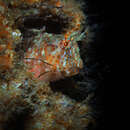Diagnostic Description
provided by Fishbase
Species distinguished by: black spot on membrane between first 2 dorsal-fin spines; mandibular sensory pore series with 5 pores per side (south Florida to Brazil); upper half of body with groups of spots forming 6 partial bars along dorsum; no orange spots in life; pelvic fins with 1 spine and 4 soft rays; pectoral-fin soft rays usually 13 or 14; segmented caudal-fin soft rays usually 13; dorsal fin not separated into 2 portions by deep notch (notch, when present, not reaching nearly to dorsal contour of body); dorsal-fin spines usually 12, the last easy to see; total dorsal-fin elements 25 to 30; an enlarged canine tooth present posteriorly on both sides of 1 or both jaws (sometimes absent on 1 side); no teeth on vomer; gill openings not continuous, each restricted to side of head, extending ventrally to about midlevel of pectoral-fin base or further (may extend completely around lower side of head and form common opening with gill opening of opposite side); cirri present only on eyes; ventral edge of upper lip smooth; lateral line never consisting of 2 disconnected, overlapping portions. Common amongst Blenniids: small, slender fishes, largest species to about 13 cm SL, most under 7.5 cm SL. Eyes high on sides of head; mouth ventral, upper jaw not protractile. A single row of incisor-like teeth in each jaw and often an enlarged canine-like tooth posteriorly on each side of lower jaw and sometimes upper jaw; no teeth on palatines. Dorsal and anal fins long, their spines usually flexible; dorsal fin with fewer spines than segmented (soft) rays; 2 spines in anal fin, scarcely differentiated from the segmented rays, the first not visible in females, both often supporting fleshy, bulbous, rugose swellings at their tips in males; pelvic fins inserted anterior to base of pectoral fins, with 1 spine (not visible) and segmented rays; all segmented fin rays, except those of caudal fin, unbranched (simple), caudal-fin rays of adults branched. All species lack scales (Ref.52855).
Life Cycle
provided by Fishbase
Oviparous, distinct pairing (Ref. 205).
Morphology
provided by Fishbase
Dorsal spines (total): 12; Analspines: 2
Biology
provided by Fishbase
Oviparous. Eggs are demersal and adhesive (Ref. 205), and are attached to the substrate via a filamentous, adhesive pad or pedestal (Ref. 94114). Larvae are planktonic, often found in shallow, coastal waters (Ref. 94114).
- Recorder
- Cristina V. Garilao
Hypleurochilus pseudoaequipinnis: Brief Summary
provided by wikipedia EN
Hypleurochilus pseudoaequipinnis is a species of combtooth blenny found in the Atlantic ocean, in the Americas it ranges from Cape Canaveral, Florida to Santa Catarina in Brazil and the eastern Atlantic it is found off Sao Tome and Principe in the Gulf of Guinea.
- license
- cc-by-sa-3.0
- copyright
- Wikipedia authors and editors

